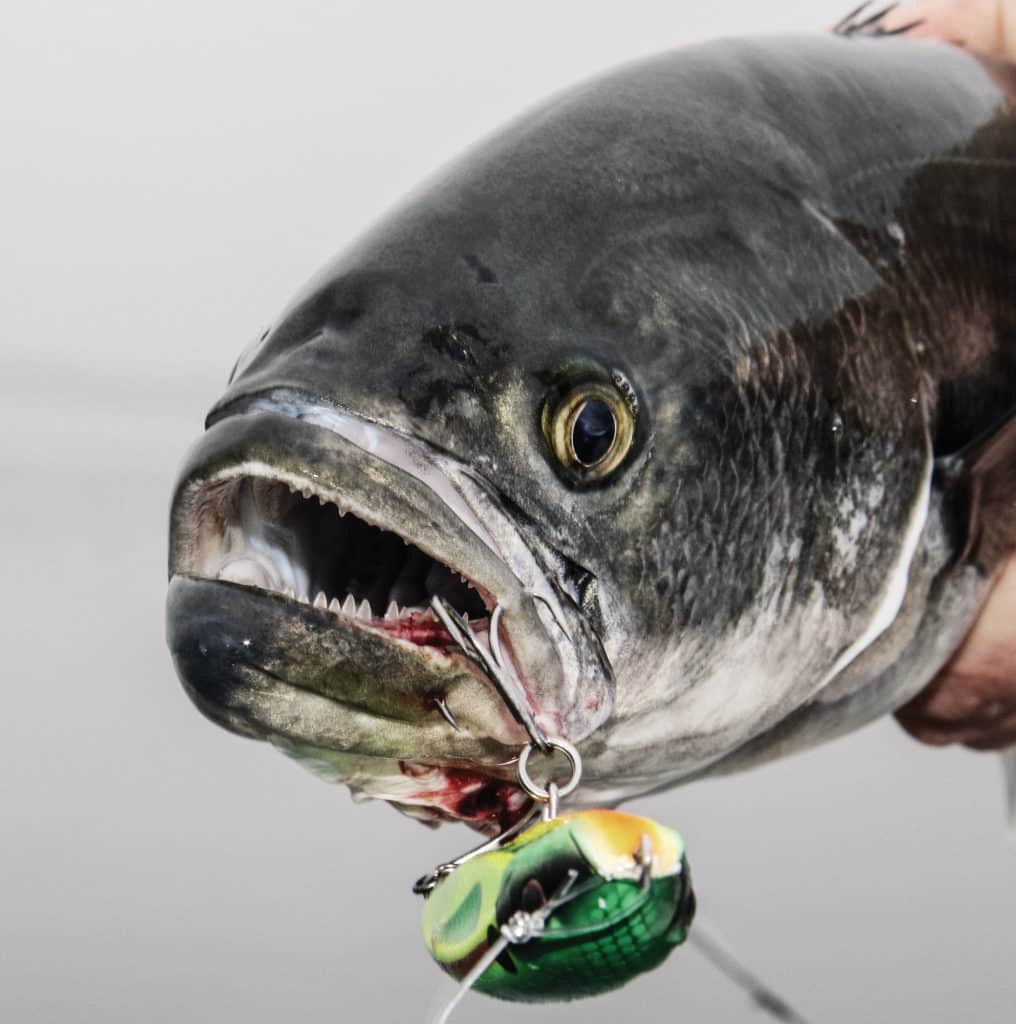
Sight-casting to gamefish prowling shallow water is hard to beat when it comes to getting a fisherman’s adrenaline pumping. And great flats fisheries around the world offer some amazing opportunities. Consider some prime examples — Islamorada in the Florida Keys for big bonefish, the Seychelles for permit, Belize for tarpon, Florida’s Mosquito Lagoon for redfish, and New York’s Jamaica Bay for bluefish. Bluefish? New York? If that item in the list above had you doing a double take, you’re forgiven. Bluefish are hardly considered a prime skinny-water sight-casting target. But as I discovered on a cool, calm evening in May a stone’s toss southeast of Brooklyn, blues offer one of the Northeast’s most exciting fisheries.
Tails, Boils and Wakes
I’d flown into the Big Apple the day before to join Capt. John McMurray, along with angler Damon Olsen, who’d also flown in for the occasion. However, Olsen, who manufactures Nomad Lures, had made a considerably longer trip — from Cairns, Australia.
Our main target wasn’t bluefish at all, but — as one might presume — striped bass. To McMurray’s chagrin, the bigger bass that are typically around by midspring hadn’t shown. We fished hard that first day, and we did catch stripers, but mostly schoolies.
As evening approached, on the way back to his home base in Oceanside, we ran along the south shore of Long Island, then turned north, following a channel that cut through a shallow bay. McMurray slowed his 33 Contender to scan the still, gray surface around the muddy, grass-covered humps still partially exposed in the flooding tide.
“They’re here,” he announced cryptically. I looked in the direction the longtime New York charter skipper pointed, at first seeing nothing, but then noting a tail — no, three tails — above the surface, moving this way and that. Except for the geography, I could have thought permit or tarpon.
“Bluefish,” McMurray explained to Olsen. The Aussie was well-versed in blues since they’re abundant around the southern (cooler) half of Australia, where they’re called “tailor.”
“Those look like big fish,” Olsen said as he tied on a Nomad Dartwing surface lure. “We don’t often see such big tailor in water as shallow as this.”
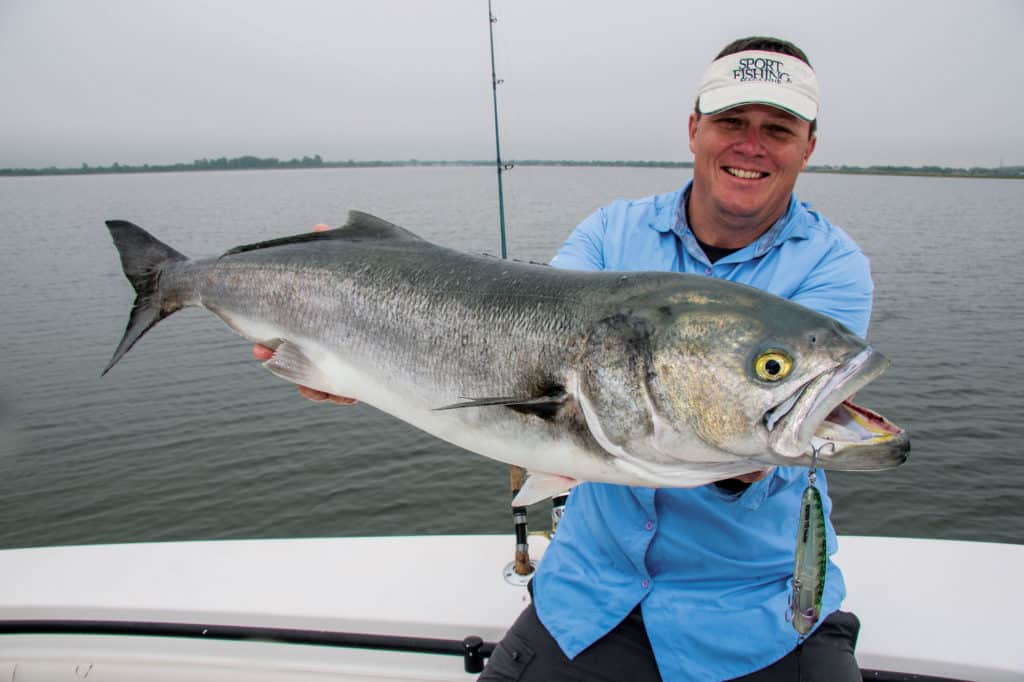
By the time Olsen and I were ready to cast, McMurray had moved the boat slightly, and now we were spotting tails, boils and wakes pretty much all around us.
I watched, keeping the bail of my little Shimano Stradic spinner open, for perhaps a minute or two. Seeing that unmistakable push of water, with shaking hands I heaved another Dartwing beyond it, already cranking when the lure touched down. Instantly the push of water became a charge as the fish bore down on the surface plug, and — wham! — it disappeared in a geyser of spray as my rod bucked and reel whirred.
While the focus of my concentration remained on the fish, peripherally I saw another fish clear the water and heard Olsen making the sort of excited exclamations anglers make when hooked up with an acrobatic fish.
And that’s pretty much the way it went for another hour and a half, with McMurray periodically relocating the boat to stay among fish, moving as the flooding tide kept changing the topography of the large, muddy bay, until it finally became too dark to see much of anything. When the dust had settled, we had lost count of how many we had released and how many more we had hooked or missed, with quite a few double-digit fish, some pushing all of 15 pounds.
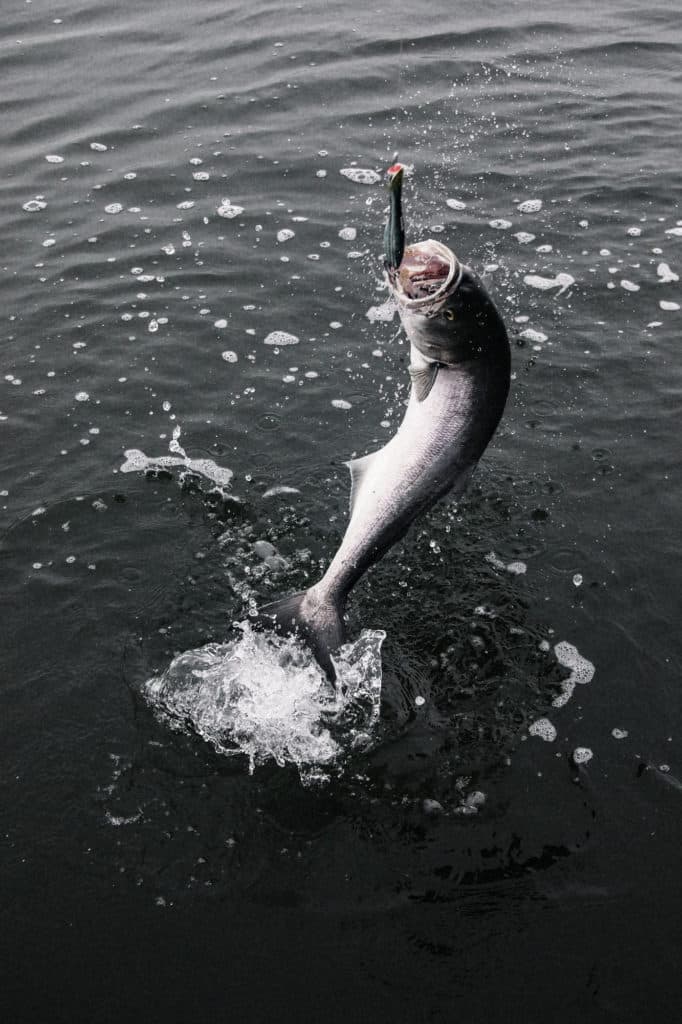
And the Hits Keep Coming
Over the next couple of days, we had ample opportunities here to try for striped bass (particularly around JFK’s runways in eastern Jamaica Bay) and offshore of New Jersey where some larger fish had been reported. Olsen was particularly keen to try out his lures on some big cow bass, and I got that. But still, I couldn’t keep from asking McMurray each day: “When will the tides be good to fish those bluefish again? And will those fish be there?”
McMurray assured me that the blues should be there, working the shallow muddy bays locally and, for that matter, regionally. During early morning or late evening when the tide was right — ideally the late flood, and particularly the early ebb — we could certainly target them.
So we did, well into the morning of our third day, fishing several acres of back-bay shallows. The early fog and haze gave way to enough filtered sunlight that seeing our quarry proved considerably easier than during our evening encounter with those marauding blues. The sight of so many fish, from modest size to those of more beastly proportions, turned Olsen and me into kids in a candy shop. More light also made it easier to fully appreciate the savage strikes so typical of blues. Best of all were the swing-and-miss attacks that often meant repeated crashes (particularly on our long casts with heavy plugs) as we cranked back lures. At times, two or three blues would compete to be caught, piling on our lures (though even then at times miraculously managing to avoid the hooks). Talk about elevated pulse rates.
The action provided Olsen a great opportunity to score some tooth marks on several models in his lineup of lures. Of course, this wasn’t the sort of finesse test where the fish are picky or lockjawed, and the blues attacked most types of lures. But for casting, it was hard to beat the excitement of poppers or shallow stickbaits. Blues tend to “want to crush anything that makes a lot of noise,” McMurray said.
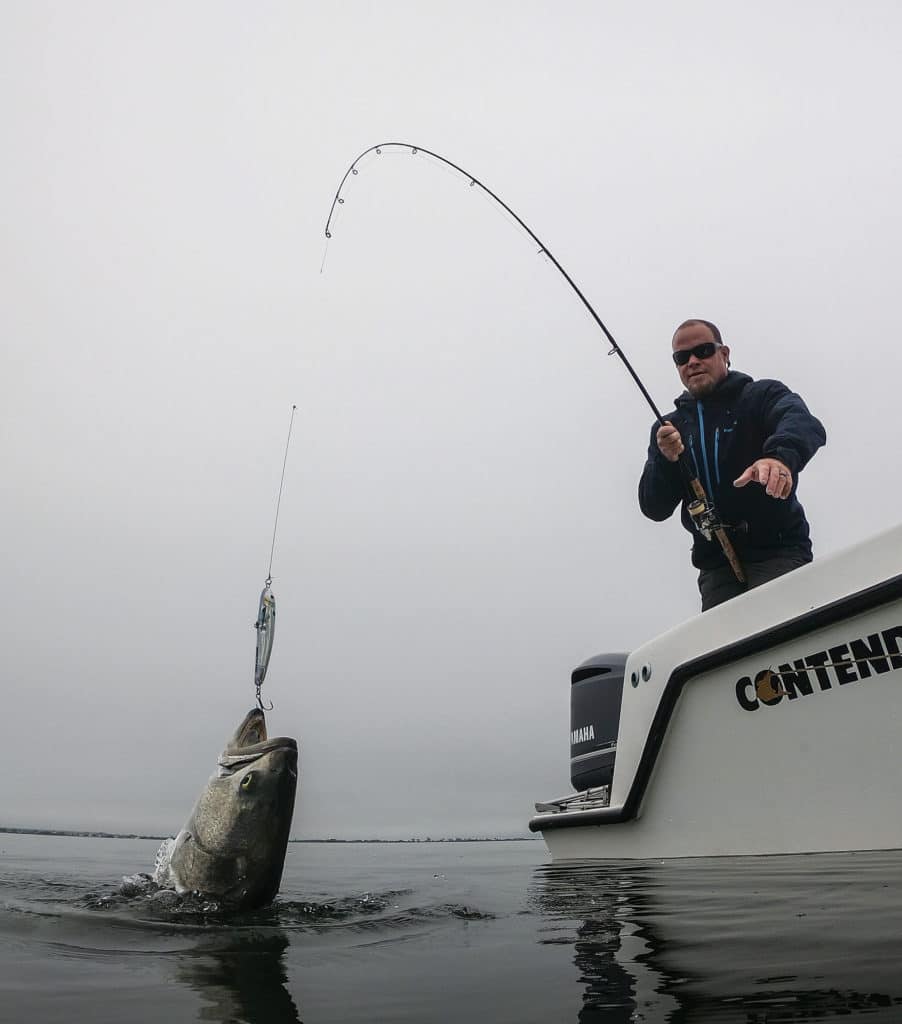
Out of the Channels
McMurray pointed out that when blues are thick, even if dinks, they’re great for kids (“They can catch ’em all day!”). For experienced anglers, not so much. But locate bigger fish on the flats where you can see them, throw a trophy-size blue in the mix now and then, and the interest level will skyrocket.
Often, the guide said, blues offer a welcome supplement to striped bass but rarely supplant them in anglers’ minds or plans. In 2018, with striped bass fishing overall not as productive as some years and with bluefish running on the large side, bluefish sight-casting was a hot ticket for those who knew how to capitalize.
McMurray said that many anglers stick to the channels, either unaware of the potential for action farther back in the shallows or unwilling to risk hanging up their boat on the muddy bottom. And make no mistake: Working in the back-bay shallows, particularly on a falling tide, can be tricky, especially in offshore or even-larger bay boats. Private boaters need to know their stuff, but the payoffs can be worthwhile.
Precise timing of “the season” for bluefish is elusive, given changing ocean-water temps and some poor-recruitment years for blues. For big fish in shallow water in most years, McMurray advised, late May/early June is the primest of prime time (for which our experience can vouch). After this period, generally the bigger blues move out, and the average size diminishes.
“But every year is different. We can and often do get a good run of big blues in late April or early May,” he pointed out, though they’re likely to be in deeper water at that time. Some years “we get a good run of big bluefish in October, even into November.” That hasn’t happened recently, but, again, McMurray said, every year differs.
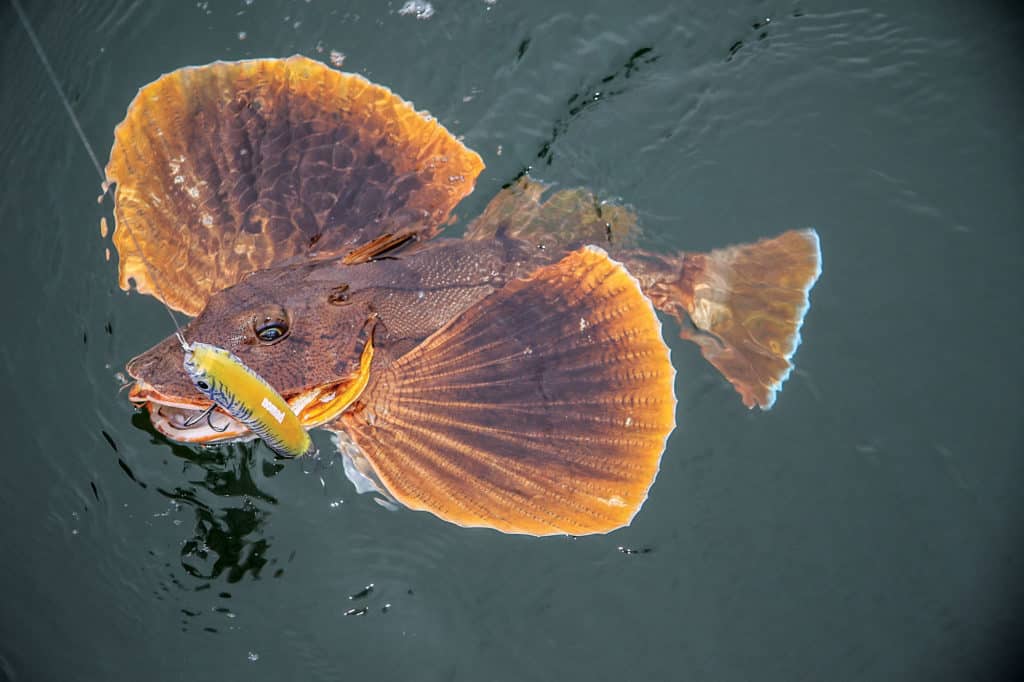
By July and through August, most of the big blues will be offshore (but bluefish being bluefish, their focus on spawning won’t make them reluctant to snap at jigs or bait).
It should be said that anglers targeting blues enjoy a good chance at some welcome bycatch. We hooked a couple of surprise stripers in the mix — not big ones, but larger bass in the back bays are always a possibility as well.
When casting for big blues in the shallows, McMurray favors 20-pound braid, though he said that going down to 15-pound should be fine. That’s what I had spooled on my light spinner and, for me, it was perfect.
While we weren’t set up for fly-casting, that’s still doable, but “it ain’t easy,” insisted McMurray, a fly-rodder himself. For this fishery, “it takes a good caster and an aggressive strip.” If one is set on trying, the guide suggested a 9-weight fast-action (tip flex) rod with 20-pound tapered leader and “as big a popping bug as you can cast.” Someone on board throwing a big hookless popper with a spinning rod can get the fish fired up for a bait-and-switch fly guy.
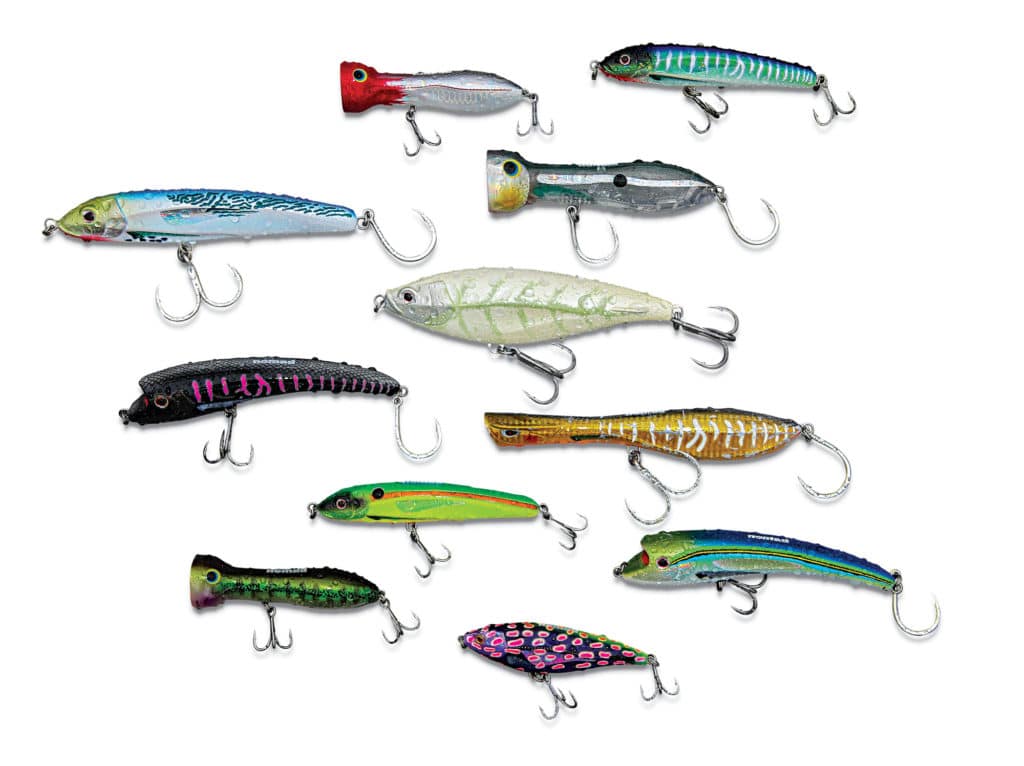
Mysterious Movements
I had figured the larger blues that moved up onto these muddy flats with the flooding tide did so while chasing baitfish. Surprisingly, that wasn’t McMurray’s observation: “Why those fish come in there is a mystery. I don’t see much bait in there most of the time. On a clear day, you can watch the bluefish playing follow the leader and daisy-chaining. Then they’ll break off and swim in circles. It sure isn’t feeding behavior.” He also noted that the fish are long and skinny, further suggesting they’re not feeding heavily.
But what’s key here is less why the bluefish move onto these shallows than the fact that they do. And for the relatively small population of anglers who know enough to take advantage of this spring fishery, it’s a blast.
“It’s like our version of a really good bonefish day,” McMurray said. “You’ve got tailing fish; you’ve got targets to cast on. These are aggressive, good-size fish that smash topwaters, jump and fight like hell. And what red-blooded angler doesn’t like that?”
Planning a Visit for Bluefish and a Lot More
When big bluefish are cruising the shallows, it’s a great fishery, and Capt. John McMurray (One More Cast Light Tackle Charters, nycflyfishing.com) is one of the area’s experts at finding and fishing them.
But McMurray’s expertise is at least as keen when it comes to stripers and bluefin tuna. With both inshore and offshore boats, McMurray takes anglers variously from skinny-water back bays to the Atlantic just off the beaches and beyond, toward the canyons, depending on what’s available and what anglers are after. Much of the year, the hunt for striped bass in the waters around New York takes center stage, but starting in July and through September, bluefin tuna fishing can be spectacular, with large to giant fish available. McMurray loves to put popping enthusiasts on big tuna when possible.
Anglers visiting the area will find accommodations aplenty. We stayed in Long Beach — close to McMurray’s home base — a laid-back, family- and tourist-friendly stretch along the Atlantic on Long Island’s southwest end. We stayed at the Allegria Hotel (allegriahotelny.com), overlooking the ocean, a place I found easy to recommend.
We also discovered some of Long Beach’s many interesting and outstanding eateries, including two small, popular and busy restaurants — Wild Feast (wildfeastfoods.com; don’t even think about not trying the fish tacos) and Lost at Sea (facebook.com/lostatsealbny), where the chefs cooked the fresh catch we provided and showed us how savory, in how many different ways, bluefish could be served. We dined as well at the hotel’s restaurant, the Atlantica, with an impressive menu and equally impressive views of the adjacent boardwalk and beach.
That boardwalk, by the way, is a great place to take a stroll on a warm summer evening. Often organized volleyball tournaments create great crowds, with dozens of nets/games going on up and down the beach, as friends and family put out lawn chairs to cheer on their teams.
For more information on visiting Long Beach, check out longbeachlife.com.









